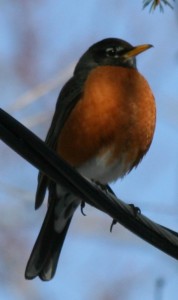General: The American Robin is one of our most common and recognizable birds. I always look forward to the first Robin of spring. For over forty years I have also looked forward to finding discarded pieces of blue Robin eggs while walking through my neighborhood in mid-spring (after the chicks hatch the parents carry the shells away from the nest).
The North American Robin is a member of the thrush family. In winter Robin roosts can be huge, sometimes including a quarter-million birds during winter – something I have witnessed crows doing in winter along the Hudson River in Troy, NY.
The American Robin is the state bird of Connecticut, Michigan, and Wisconsin.
The Robin breeds throughout most of North America, from Alaska and Canada southward to northern Florida and Mexico.
Because the robin forages largely on lawns, it is vulnerable to  pesticide poisoning and can be an indicator of chemical pollution. Robins found in suburban and urban areas have lead levels in their blood that are roughly twice as high as robins from rural areas and the amount of lead in their blood suggest that some symptoms of lead poisoning are being manifested. Researchers have found that Robins appear to be a favored target of mosquitoes and many have Nile-Virus antibodies in their blood, this means that they were infected but have survived. (1)
pesticide poisoning and can be an indicator of chemical pollution. Robins found in suburban and urban areas have lead levels in their blood that are roughly twice as high as robins from rural areas and the amount of lead in their blood suggest that some symptoms of lead poisoning are being manifested. Researchers have found that Robins appear to be a favored target of mosquitoes and many have Nile-Virus antibodies in their blood, this means that they were infected but have survived. (1)
In spring, males attract females by singing, raising and spreading their tails, shaking their wings and inflating their white-striped throats. They nest commonly above the ground in a bush or in a fork between two tree branches. The female lays three to five light blue eggs, and is incubates them alone. Incubation is about 12-14 days, the chicks are helpless at birth, mostly naked with spare whitish down. They fledge in about 14-16 days. The adult male and female both are active in protecting and feeding the fledged chicks until they learn to forage on their own. Robins usually have 2 broods during breeding season.
Identification: American Robins are fairly large songbirds with a large, round body, long legs, and fairly long tail. They are 7.9”–11” long with a wingspan of 12.2”–15.7”. They weigh approximately 2.7–3 oz. Robins are the largest North American thrushes.
American Robins are gray-brown with orange under parts and dark heads. In flight, a white patch on the lower belly and under the tail can be conspicuous. Compared with males, females have paler heads that contrast less with the gray back.
Habitat: American Robins can be found on lawns in fields, and city parks, as well as in more wild places like woodlands, forests, mountains up to near treeline, recently burned forests, and tundra. During winter many robins move to moist woods where berry-producing trees and shrubs are common.
Territory: The American Robin has an extensive range throughout North America, wintering south of Canada from Florida to central Mexico and along the Pacific Coast.
Migration: Most North American Robins migrate in August to winter south of Canada from Florida and the Gulf Coast to central Mexico, as well as along the Pacific Coast.
Food: The Robin’s diet consists of invertebrates (such as beetle grubs and caterpillars), fruits and berries. Nestlings are fed mainly on worms and other soft-bodied animal prey.
(1) National Science Foundation: West Nile Virus: The Search for Answers in Chicago’s Suburbs